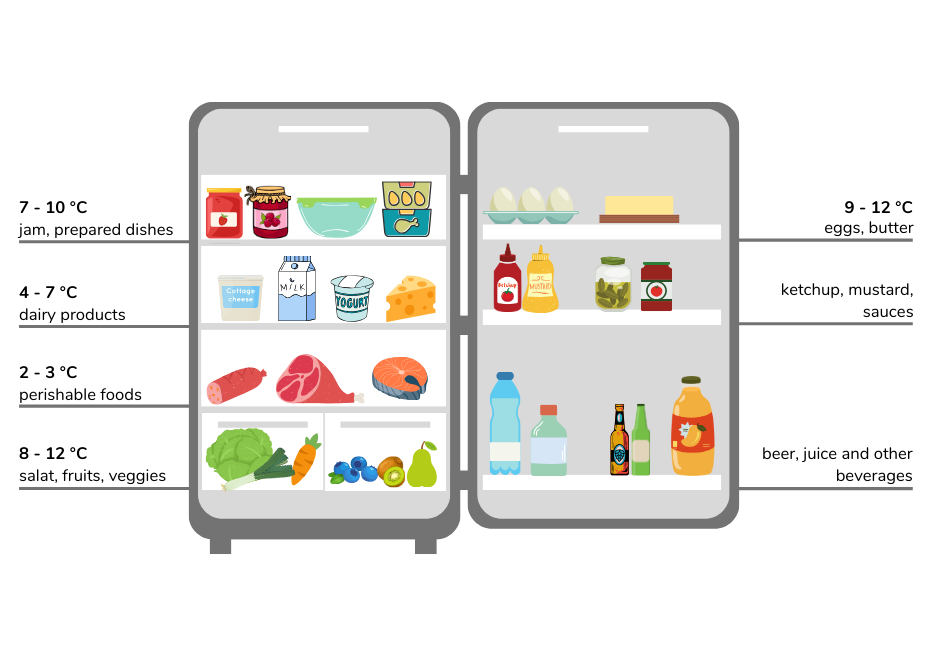
Major points:
- In this article, you will learn how to properly store your food in the fridge and whether a certain type of food should be refrigerated or not.
- Your food stays fresher and lasts longer when stored correctly, as the temperature can vary significantly between different levels of the fridge.
- Perishable foods should be stored in lower compartments, where the temperature is lower.
Tips & Tricks on how to properly organize your fridge
You went shopping, encountered many great deals, and now you are standing in front of a huge pile of groceries that all need a place in your fridge…
Your food stays fresher and lasts longer if you sort it correctly, thus we have gathered some valuable tips for arranging your fridge.
What you need to know about your fridge
The optimal temperature for a fridge is between 5 and 7 degrees Celsius. The temperature decreases from the top compartments to the lower compartments because warm air generally rises upwards. Additionally, the temperature increases from the back wall, where the cooling system is installed, towards the door.
The vegetable compartment, which is usually located at the bottom of the fridge, is an exception. Although it is still located below the coldest compartment, the temperature here is significantly higher due to the glass bottom and plastic drawers.
An overview of the individual temperature zones in the fridge:
- Lower compartment: 2 to 3 degrees Celsius
- Middle compartment: 4 to 7 degrees Celsius
- Upper compartment: 7 to 10 degrees Celsius
- Vegetable compartment: 8 to 12 degrees Celsius
- Door: 9 to 12 degrees Celsius
Even inside the fridge door, there are temperature differences from bottom to top. Generally, the entire door is the warmest place in the fridge, as it is furthest away from the cooling units. You can use these temperature differences to best arrange the different foods in your fridge, keeping them fresh and long-lasting. In addition, some foods, such as sausages and cheese, develop their flavor much better when stored in the right area.
The proper storage for different foods
The bottom compartment is by far the coldest. It is the ideal place to store quickly perishable foods:
- raw meat
- sausages
- ham
- raw fish
The middle compartment is suitable for opened and still packaged dairy products:
- cheese
- cream
- fresh milk
- yogurt
- curd
The upper compartment is suitable for foods that do not quickly perish:
- jam
- cooked/fried meat
- prepared dishes
- original packed cheese
- fresh cheese
- opened canned food
The vegetable compartment: before storing foods in the vegetable compartment, you should remove any existing plastic packaging to prevent condensation leading to mold. Since the vegetable compartment is closed, the ethylene contained in some fruits cannot escape leading to accelerated ripening. Therefore, foods that emit a high amount of ethylene like apples or bananas should not be stored there.
The vegetable compartment is perfect for the following vegetables and fruits:
- root vegetables (e.g., carrots, radishes, parsnips)
- mushrooms
- leeks, spring onions
- cabbage
- broccoli
- cauliflower
- kohlrabi
- spinach
- herbs
- berries
- kiwis
- grapes
- cherries
- figs
The upper door compartment is most suitable for storing less perishable foods:
- eggs
- butter
- margarine
The middle door compartment is suitable for the storage of:
- ketchup
- mustard
- dressings
- sauces
- opened jars, such as pickles
You can use the lower door compartment for the storage of:
- beverages, including opened and fresh juices, beer, wine, etc.

As a general rule, the more perishable the food, the further down it should be stored in the fridge, as the temperature is lower there.
Food that is not suitable for storage in the fridge
Not every food belongs in the fridge. The following foods should not be kept refrigerated, e.g., some vegetables and fruits retain their flavor and vitamins longer if they are not stored in the fridge. Fruits and vegetables should also generally be stored separately, as fruits ripen and emit ethylene, which causes vegetables to perish more quickly.
The following types of fruit should not be stored in the fridge:
- citrus fruits, such as oranges, tangerines, limes, lemons, grapefruits
- mangoes
- pineapples
- papayas
- melons
- bananas
- apples
- pears
The following vegetables stay fresh for longer at room temperature:
- tomatoes
- cucumbers
- carrots
- onions and garlic
- potatoes
- avocado
- basil
Other foods that should be stored outside the fridge are:
- honey
- olive oil
- bread
- coffee
- nuts
Help - my fridge smells!
If your fridge smells, the first thing you should do is check if the smell comes from spoiled food.
In addition to glass and metal, you will find plastic and rubber seals in the fridge that take on odors as it ages. The drainage channel, which is located on the rear wall and drains condensation water, also tends to accumulate water or spilled liquids, which can spread unpleasant odors.
Tip: Always put liquids (especially opened packages) only into the door, since in the compartments they could tip over and leak.
A number of so-called odor eliminator or odor neutralizers are on offer, which absorb the odor molecules by means of activated carbon. But there are also some home remedies that you can use to tackle the odors.
Here are some examples:
- Baking soda: Place two to three teaspoons of baking soda in a small, shallow container in a corner of the fridge. This will bind and neutralize the odors. Baking soda needs to be replaced about once a month.
- Coffee: Coffee should not be placed in the fridge for storage, because if you store it openly, it quickly takes on the smells of the other fridge guests. Because of this property, coffee is excellent for binding unpleasant odors. Again, place two to three teaspoons of freshly ground coffee in a small container in the corner of the fridge and renew about once a month.
- Lemon juice/lemon peel: Lemon juice or lemon peel can also deal with unpleasant odors. Simply place the peel of the lemon with some lemon juice in a small container and replace about every four to five days.

Important: Never put warm or even hot food in the fridge!
When you put warm or hot food in the fridge, the entire fridge heats up and it takes a long time to restore the optimal temperature. This consumes much more energy and results in unnecessary energy costs. Furthermore, condensation occurs, which can lead to a buildup of ice.
Now you already know how to organize your fridge. The only thing left to do now is to cook. If you’re not yet familiar with cooking, take a look at our article Cooking for beginners.
